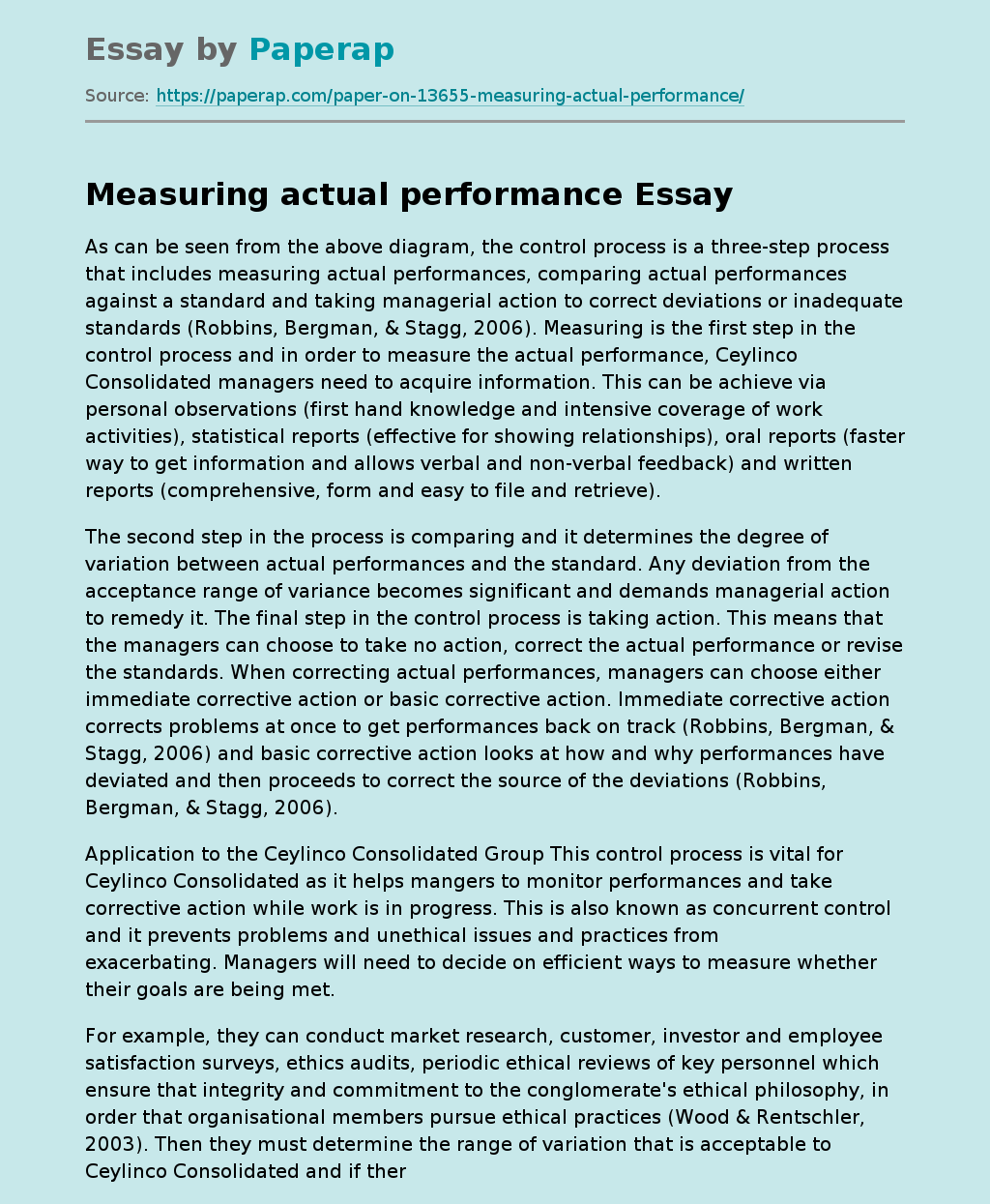Measuring actual performance
As can be seen from the above diagram, the control process is a three-step process that includes measuring actual performances, comparing actual performances against a standard and taking managerial action to correct deviations or inadequate standards (Robbins, Bergman, & Stagg, 2006). Measuring is the first step in the control process and in order to measure the actual performance, Ceylinco Consolidated managers need to acquire information. This can be achieve via personal observations (first hand knowledge and intensive coverage of work activities), statistical reports (effective for showing relationships), oral reports (faster way to get information and allows verbal and non-verbal feedback) and written reports (comprehensive, form and easy to file and retrieve).
The second step in the process is comparing and it determines the degree of variation between actual performances and the standard. Any deviation from the acceptance range of variance becomes significant and demands managerial action to remedy it. The final step in the control process is taking action. This means that the managers can choose to take no action, correct the actual performance or revise the standards.
When correcting actual performances, managers can choose either immediate corrective action or basic corrective action. Immediate corrective action corrects problems at once to get performances back on track (Robbins, Bergman, & Stagg, 2006) and basic corrective action looks at how and why performances have deviated and then proceeds to correct the source of the deviations (Robbins, Bergman, & Stagg, 2006).
Application to the Ceylinco Consolidated Group This control process is vital for Ceylinco Consolidated as it helps mangers to monitor performances and take corrective action while work is in progress.
This is also known as concurrent control and it prevents problems and unethical issues and practices from exacerbating. Managers will need to decide on efficient ways to measure whether their goals are being met.
For example, they can conduct market research, customer, investor and employee satisfaction surveys, ethics audits, periodic ethical reviews of key personnel which ensure that integrity and commitment to the conglomerate’s ethical philosophy, in order that organisational members pursue ethical practices (Wood & Rentschler, 2003). Then they must determine the range of variation that is acceptable to Ceylinco Consolidated and if there are any significant deviations, decide on what course of action to follow (if the managers find that the market research and surveys show no improvement in the perceptions of their stakeholders, they could either take basic or immediate corrective action to rectify the situation).
Summary In summary, Ceylinco Consolidated needs a more effective group approach to decision procedures in the boardroom and an enhanced collective involvement by internal stakeholders (employees) in the organizational decision-making process (Holloway & Van Rhyn, 2005). The management functions of planning and controlling play a decisive role in restoring the conglomerate’s credibility and trust in the eyes of its stakeholders through the implementation of a strong code of ethics, new and effective control procedures.
The management function of planning will assist managers is establishing the code of ethics and implementing goals and values to achieve them. Controlling using ethics audits, market surveys and periodical ethical reviews of key employees, screening of potential employees and replacing the current top management with carefully selected persons proven to follow a strong code of ethics will go a long way to improving the company’s public image.Replace current management with leaders who have proven their ethical leadership.
Replace the current board of directors with a new independent board (one that has no professional or personal ties with the company and its subsidiaries, either current or former) that focuses on monitoring the CEO, Chairman, overseeing the conglomerate’s strategy and monitors the company’s control system, thus preventing further frauds from occurring. Promote pre-hiring screening tests to ensure ethical practices. Implementation of legislation like the Sarbannes-Oxley Act in July 2002 aimed at curtailing (misbehaving) senior managers of corporate entities (Holloway & Van Rhyn, 2005).
References
Core Business . (n.d.). Retrieved May 15, 2009, from Ceylinco Consolidated: http://www.ceylincoconsolidated.com/core_business.html
Eye, E. (2009, March 8 Volume 15, No. 35). “Swindler’s List”. Retrieved May 15, 2009, from The Sunday Leader Online Edition: http://www.thesundayleader.lk/20090308/exposive.HTM
Harrison, E. F. (1996, Volume 34 Issue 1). A Process Perspective On Strategic Decision Making. Management Decision , p. 46.
Holloway, D. A., & Van Rhyn, D. (2005, Volume 11). Effective Corporate Governance Reform and Organisational Pluralism: Reframing Culture, Leadership and Followership. Advances in Public Interest Accounting .
Measuring actual performance. (2018, Jan 30). Retrieved from https://paperap.com/paper-on-13655-measuring-actual-performance/

